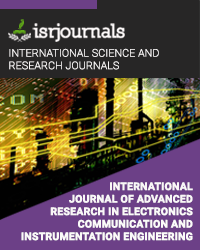audio feature extracton and classification using wavelet transform and svm tool
S Ilaiyaraja,Nandhini P,Infant Sneha C,Sangamithira I
Published in International Journal of Advanced Research in Electronics, Communication & Instrumentation Engineering and Development
ISSN: 2347 -7210 Impact Factor:1.9 Volume:1 Issue:2 Year: 08 February,2014 Pages:71-70

Abstract
Feature extraction and analysis are the foundation of audio classification. Here we propose an improved audio classification and categorizing method which makes use of wavelets and Support Vector Machines (SVM’s).An audio signal is preprocessed using hamming window when a audio is given, wavelets are first applied to extract acoustical features such as sub-band power & pitch information. Also by using Fourier transform Bandwidth & Brightness of the audio features are extracted features are extracted. The proposed method uses SVM over these acoustical Features and additional parameters such as mean and median values of acoustical features.
Kewords
multimedia environmental
Reference
[1] E. Wold, T. Blum, D. Keislar, and J. Wheaton, “Content-based classification, search and retrieval of audio,” IEEE Multimedia, vol. 3, no. 3, pp. 27–36, Jul. 1996. [2] S. Z. Li, “Content-based audio classification and retrieval using the nearest feature line method,” IEEE Trans. Speech Audio Process., vol. 8, no. 5, pp. 619–625, Sep. 2000. [3] T. Zhang and C.-C. J. Kuo, “Audio content analysis for online audiovisual data segmentation and classification,” IEEE Trans. Speech Audio Process., vol. 9, no. 4, pp. 441–457, May 2001. [4] L. Lu, H.-J. Zhang, and H. Jiang, “Content analysis for audio classification and segmentation,” IEEE Trans. Speech Audio Process., vol. 10, no. 7, pp. 504–516, Oct. 2002. [5] G. Guo and S. Z. Li, “Content-based audio classification and retrieval by support vector machines,” IEEE Trans. Neural Networks, vol. 14, no. 1, pp. 209–215, Jan. 2003. [6] F. Melgani and L. Bruzzone, “Classification of hyperspectral remote sensing images with support vector machines,” IEEE Trans. Geosci. Remote Sens., vol. 42, no. 8, pp. 1778–1790, Aug. 2004. [7] P. Clarkson and P. J. Moreno, “On the use of support vector machines for phonetic classification,” in Proc. IEEE Int. Conf. Acoustics, Speech, Signal Process., vol. 2, Mar. 1999, pp. 585–588. [8] V. N. Vapnik, Statistical Learning Theory. New York: Wiley, 1998. [9] V. Kecman, Learning and Soft Computing. Cambridge, MA: MIT Press, 2001. [10] P. Ding, Z. Chen, Y. Liu, and B. Xu, “Asymmetrical support vector machines and applications in speech processing,” in Proc. IEEE Int. Conf Acoustics, Speech, Signal Process., vol. 1, May 2002, pp. I-73–I-76.

